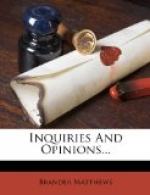In her encroaching on the domain of the other muses, the prose-epic has annexed far more from her comic and tragic sisters than from any of the other six. An opportunity for a most interesting inquiry awaits the alert scholar who shall undertake to tell the rivalry of the novel and the play, tracing their influence on each other and making a catalog of their mutual borrowings. Altho the record has no special significance, it may be noted that they have never hesitated to filch plots from each other, the playwrights appropriating the inventions of the novelists and the novelists levying on the works of the playwrights,—Shakspere, the dramatist, finding the action of his ‘As You Like It’ ready to his hand in a tale of Lodge’s, and Le Sage, the story-teller, in his ‘Gil Blas’ availing himself of scenes from Spanish comedies.
Far deeper, however, than any purloining of material are other interrelations of the novel and the play, which have been continually influencing one another, even when there was no hint of any plagiarism of subject-matter. The older of the two, the drama, long served as the model of prose-fiction; and not a few of the earlier practitioners of the later art began their literary careers as writers for the theater,—Le Sage for one, and, for another, Fielding. It is not to be wondered at that they were inclined to approach the novel a little as tho it were a play, and to set their characters in motion with only a bare and summary indication of the appropriate environment. They were inclined to follow the swift methods proper enough on the stage, if not absolutely necessary there, instead of developing for themselves the more leisurely movement appropriate to prose-fiction. Both Fielding and Le Sage, it may be well to note, had profited greatly by their careful study of Moliere and of his logical method of presenting character. In the ’Princess of Cleves,’—perhaps the first effort at feminine psychology in fiction,—we discover the obvious impress of both Corneille and Racine on Madame de Lafayette,—the stiffening of the will to resolute self-sacrifice of the elder dramatist and the subtler analysis of motive dexterously attempted by the younger and more tender tragic poet.
Just as Beaumarchais in the eighteenth century found his profit in a study of Le Sage’s satiric attitude, so Augier in the nineteenth century, and still more, Dumas fils, responded to the sharp stimulus of Balzac. The richer and far more complicated presentation of character which delights and amazes us in the ‘Human Comedy’ was most suggestive to the younger generation of French dramatists; and no one can fail to see the reflection of Balzac in the ‘Maitre Guerin’ of Augier and in the ‘Ami des femmes’ of Dumas. And, in their turn, these plays and their fellows supplied a pattern to the novelist—to Daudet especially. A certain lack of largeness, a certain artificiality of action in Daudet’s ‘Fromont jeune et Risler aine,’ is probably to be ascribed to the fact that the story was first conceived in the form of a play, altho it was actually written as a novel.




